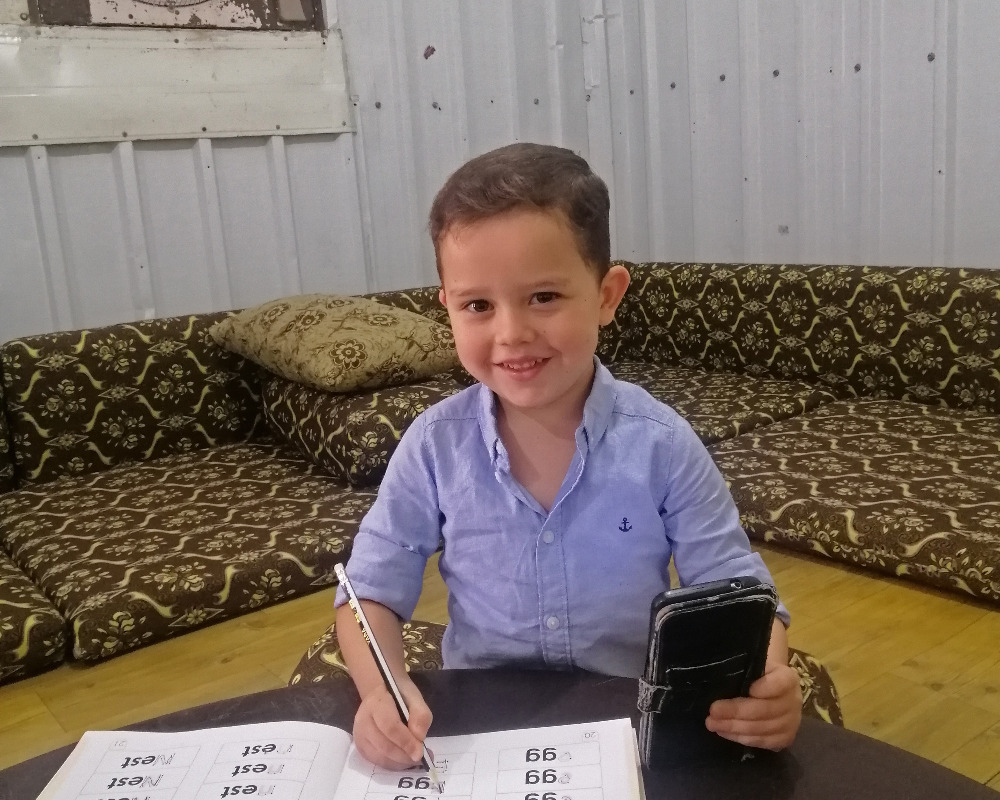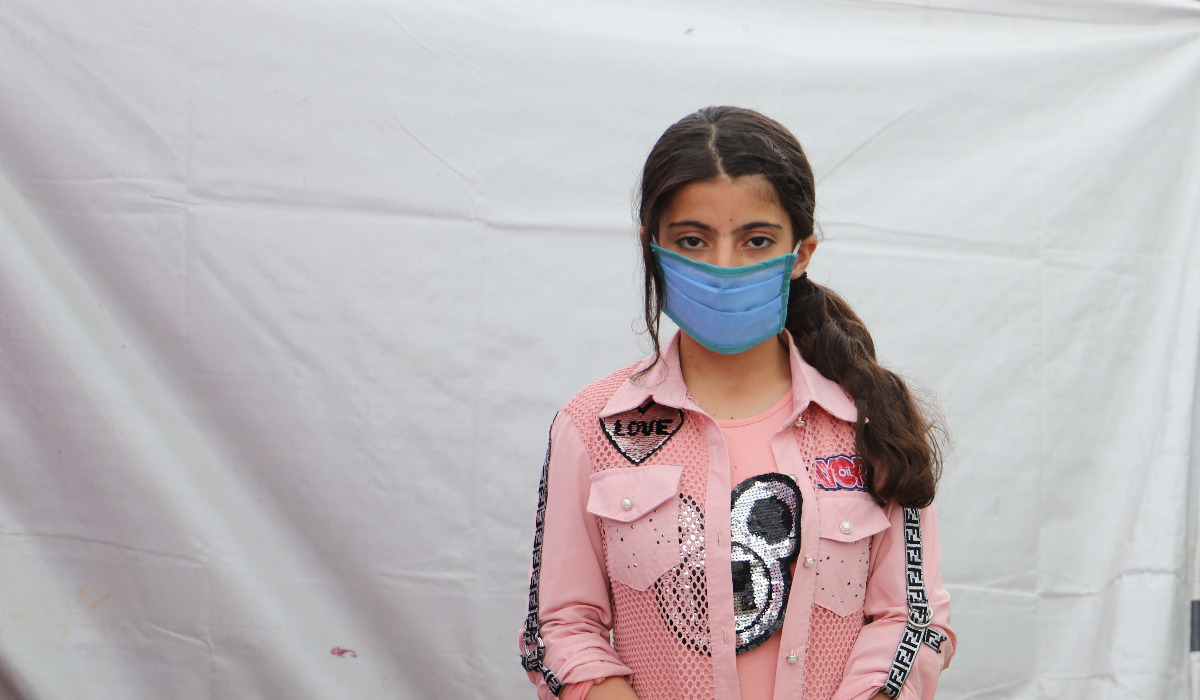
Remote schooling brings hope to Qutaibah during isolation.
But thanks to you, World Vision is providing remote learning with homework and study materials to ensure children still have some sense of normality and something to look forward to.


Your support is helping child refugees
Syrian refugees, like 12-year-old Yasmin (pictured above), living in tents, are especially vulnerable to the virus.
With your help, we’re going further to save and protect children from the devastating effects of coronavirus.
Children like Qutaibah, 5, who was born in Azraq refugee camp in Jordan. It’s the only life he’s ever known. Families like his are used to living in uncertainty, not knowing if and when they will get to go home.
Education is a lifeline for children like Qutaibah, giving them the opportunity to learn, play and express themselves. He regularly attended the children’s centre in the camp. The education centre provides lessons in Arabic, English, maths, art and music as well as a kindergarten curriculum and emotional and psychological support.
Now that he – and thousands more – have to stay at home, this has been taken away.
But thanks to you, World Vision is providing remote learning with homework and study materials to ensure children still have some sense of normality and something to look forward to.
This is just one example of how our supporters are helping us respond to the devastating impact of coronavirus in more than 70 countries. So far, we’ve reached over 37 million people including children. Our goal is to limit the spread of coronavirus and reduce its impact on vulnerable children and their families.
Thanks to supporters like you, we can continue to save and protect children, helping them survive, recover from their trauma and rebuild a future.
Frequently Asked Questions
1. Where is World Vision responding to the crisis?
World Vision is active in nearly 100 countries. When disaster strikes, we are active on the ground, quickly providing immediate support. We are responding in over 70 countries, aiming to reach 72 million people through a $350 million response, with a special focus where people are most vulnerable.
Some examples:
Africa
In Malawi, some communities still did not believe that they could contract COVID-19. After awareness campaigns were conducted, these communities are now adopting preventive measures like putting on face masks and washing of hands. World Vision has also provided PPE to health centres after some communities expressed concern over the lack of supplies.
Asia
In Vietnam, our staff have worked closely with local radio stations to disseminate vital knowledge and skills, helping to ensure communities stay safe.
Latin America & the Caribbean
In Brazil, hospital ship ‘Solidarity’ made its second trip along the Solimões River to reach vulnerable children and families. World Vision is visiting 12 communities, delivering aid to more than 500 families.
Middle East & Eastern Europe
In Lebanon, our rapid assessments after August’s explosion showed that food, shelter and hygiene items were urgently required and we were able to start distributions straight away. In the midst of the COVID-19 pandemic, personal protective equipment kits will also be required to prevent the virus spread and reduce the impact on an overstretched health system.
2. How is World Vision responding?
Our response focuses on three key areas:
1. Promoting preventative measures to stop or slow the spread of COVID-19
We’re promoting hand washing and respiratory hygiene amongst communities and households, and both working with community health workers and volunteers and using digital channels to share the messages more widely. We have also been setting up public handwashing stations and distributing soap, sanitiser and masks where appropriate.
2. Supporting health systems and workers
We have been providing personal protective equipment (e.g. masks and gowns) and treatment supplies (e.g. thermometers); training and equipping community health workers to help with home care for the sick, to share stay-healthy messaging, and to help run isolation centres and transport for the sick.
3. Supporting children impacted by COVID-19
Education: Including, supporting authorities to ensure safe school operations (promoting procedures for staff and students that become unwell, information sharing and targeted age-specific health education), supporting children, families and teachers to continue education if schools are closed (e.g. home learning materials/activity packs).
Child Protection: Including, awareness-raising with Child Protection/social workers; preventing separation and stigmatisation of children and caregivers during treatment and isolation; psychological first aid for children and caregivers; monitoring and responding to increases in child labour, begging, abuse, sexual violence, or neglect.
Livelihoods: Including providing cash and vouchers, and distributing food and care packs for people in isolation.
4. How is World Vision positioned to support vulnerable children during the crisis?
World Vision has a presence in almost 100 countries around the world. We work with the most vulnerable children and communities facing the challenges created by poverty and injustice.
Partnerships with faith leaders: Our work is inspired by our Christian faith, and our partnerships with faith and community leaders are critical as we join hands to strengthen preparedness, change behaviour and protect children and other vulnerable people.
Our Channels of Hope programme already equips faith leaders to support their communities when epidemics arise. Our experience with Ebola and Zika viruses has shown that when trusted faith leaders engage with their communities, real breakthroughs can be achieved in slowing the spread of disease.
We’re working alongside 7,000 faith leaders in 80 countries, sharing messages about prevention. And we know that this community approach is effective.
Child Sponsorship: Our Child Sponsorship model empowers communities to support vulnerable children and their families through sustainable approaches to build child well-being.
We employ local staff members and volunteers who usually live within or close to the communities where they work. They are seen as friends, confidants, encouragers and trustworthy partners which is vital during a pandemic response.
Our staff are working with their local communities to amplify prevention and control messages whilst supporting the protection of children. This may involve supporting education whilst schools are closed, preventing separation of children from their caregivers during treatment and isolation, and delivering livelihood activities and cash, food and care packs to people in isolation.
5. How are my donations to World Vision helping?
Your donations are helping save and protect children in the world’s most dangerous places; wherever they are most needed. This includes preventing the spread of coronavirus and reaching children with remote learning and psychological support to help them recover from their trauma and rebuild a future.
You can protect children living in some of the most dangerous places
DonateMore stories
We use cookies and similar technologies to help personalise content, tailor and measure ads, and provide a better experience.